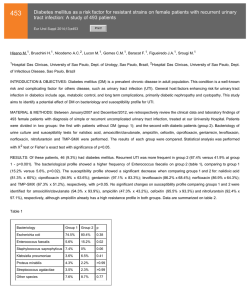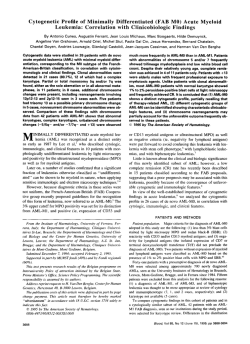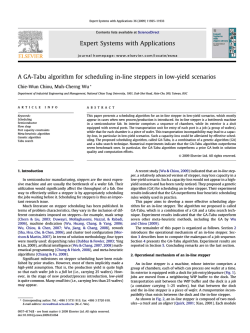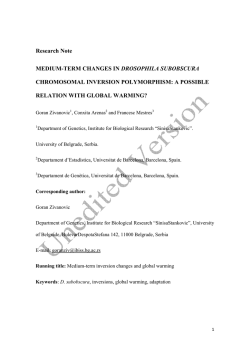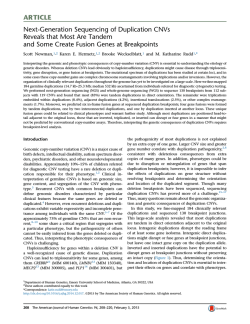
Cytogenetic analysis of children under long-term
Mutation Research 491 (2001) 25–30 Cytogenetic analysis of children under long-term antibacterial therapy with nitroheterocyclic compound furagin G. Slapšyt˙e a,∗ , A. Jankauskien˙e b , J. Mierauskien˙e a , J.R. Lazutka a a b Department of Botany and Genetics, Vilnius University, ˇ 21 Ciurlionis St., 2009 Vilnius, Lithuania Department of Pediatrics, Vilnius University Children’s Hospital, 7 Santariški˛u St., 2600 Vilnius, Lithuania Received 6 June 2000; received in revised form 14 November 2000; accepted 19 November 2000 Abstract Cytogenetic analysis of chromosome aberrations (CAs) and sister chromatid exchanges (SCEs) was performed in 109 blood samples from 95 pediatric patients with urinary tract infections (UTIs). Children were exposed to diagnostic levels of X-rays during voiding cystourethrography and subsequently treated for one to 12 months with low doses of furagin — N-(5-nitro-2-furyl)-allylidene-1-aminohydantoin. Furagin is 2-substituted 5-nitrofuran, chemically and structurally similar to well-known antibacterial compound nitrofurantoin. Increased frequencies of CAs were found in children undergoing voiding cystourethrography as compared with the unexposed, acentric fragments being the most frequent alteration (2.03 versus 0.88 per 100 cells, P = 0.006). However, a significant decrease in the frequency of acentric fragments was determined with the time elapsed since X-ray examination was performed. A time-independent increase in SCE frequency was found in lymphocytes of children treated with furagin. Total CA frequency did not differ significantly between groups of children with various duration of furagin treatment. However, frequency of chromatid exchanges (triradials and quadriradials) increased significantly with duration of treatment. © 2001 Elsevier Science B.V. All rights reserved. Keywords: Furagin; Chromosome aberration; Sister chromatid exchange; Human lymphocytes; Ionizing radiation 1. Introduction Many nitrofurans are known for their excellent antibacterial action and, therefore, are widely used in clinical [1] and veterinary [2] practice. Furagin (furazidine) — N-(5-nitro-2-furyl)-allylidene)-1-aminohydantoin, CAS No. 1672-88-4 — is 2-substituted 5-nitrofuran chemically and structurally similar to the well-known antibacterial compound nitrofurantoin. ∗ Corresponding author. Tel.: +370-2-332-864; fax: +370-2-333-844. E-mail address: [email protected] (G. Slapšyt˙e). As nitrofurantoin, furagin is used in the therapy of urinary tract infections (UTIs). It is used, however, mainly in states of the former Soviet Union [3] and some eastern European countries [4]. Clinical trials in some western European countries were performed, too [5]. Data on genotoxicity of furagin are scarce. In some papers, mutagenicity of furagin in E. coli has been described [6–8]. In one study, genotoxicity of nitrofurantoin and furagin at equimolar concentrations was compared using the Ames test, chromosome aberrations (CAs) and sister chromatid exchanges (SCEs) in cultured human lymphocytes, sex-linked 1383-5718/01/$ – see front matter © 2001 Elsevier Science B.V. All rights reserved. PII: S 1 3 8 3 - 5 7 1 8 ( 0 1 ) 0 0 1 3 1 - 0 26 G. Slapšyt˙e et al. / Mutation Research 491 (2001) 25–30 recessive lethals and dominant lethals in Drosophila melanogaster [9]. It appeared that furagin and nitrofurantoin had similar genotoxic potencies. No studies of patients receiving furagin therapy have been performed until now. Contrary to furagin, there are numbers of studies concerning genotoxicity of its congener nitrofurantoin in vitro and in vivo. Nitrofurantoin was clearly mutagenic in vitro for bacteria [10] and mammalian cells [11]. Nitrofurantoin induced chromosome damage in rodent bone marrow in vivo [12], but no induction of somatic gene mutations in mouse embryos [13] and CA in spermatocytes [14] was detected. One study performed with people showed that nitrofurantoin does not cause detectable cytogenetic abnormalities in lymphocytes of adult UTI patients [15]. Urinary tract infection is one of the most prevalent form of infectious diseases among children. Recurrence of UTI is common in susceptible individuals, especially in those with vesicouretheral reflux. Long-term low-dose antimicrobial prophylaxis often is necessary in such patients. Nitrofurans, mostly nitrofurantoin, are used effectively in preventing recurrences of UTI for many years [16]. Use of furagin for these purposes have also been suggested [3]. Since such low-dose antimicrobial therapy may last up to 12 months, it is quite important to know whether furagin is able to induce cytogenetic damage in lymphocytes of the treated patients. Precise diagnosis of UTI in children is unavoidably associated with cystourethrography. Although X-ray doses received during medical examinations are usually low, exposures to even such low levels of ionizing radiation have been reported to produce chromosome damage in lymphocytes of the exposed persons. Significant increase of chromosome damage was reported in patients undergoing gastro-intestinal studies [17], mammography [18], cardiac catheterization and computed tomography [19], and in patients monitored with multiple chest fluoroscopies [20]. In the present study, two cytogenetic endpoints (CA and SCE) were used as indicators of the chromosome damage in peripheral blood lymphocytes of pediatric UTI patients exposed to diagnostic levels of X-rays during voiding cystourethrography and subsequently treated with low doses of furagin for one — 12 months. 2. Materials and methods 2.1. Patients One hundred and nine blood samples were taken from 95 children suffering from UTI (mainly pyelonephritis and chronic cystitis) and hospitalised in Vilnius University Children’s Hospital. With parental consent an extra 2-ml blood samples from children were obtained when blood was collected for routine biochemical monitoring. Their ages ranged from 0.2 to 13 years, with a mean of 5.9 ± 0.3 years. The blood urea nitrogen and creatinine levels of all patients were within the normal range: blood urea nitrogen levels ranged from 3.0 to 6.9 mmol/l; creatinine from 0.03 to 0.08 mmol/l. Twenty-three children were studied at the diagnosis and had no previous medication. Others had received antibiotics, mainly ampicillin (50–100 mg/kg per day) or gentamicin (3 mg/kg per day) for periods up to 7 days. All patients had undergone voiding cystourethrography (effective dose equivalent to the procedure involving two film exposures was 0.4–2.4 mSv) before the long-term antimicrobial therapy with furagin. The treatment with furagin consisted of oral administration in doses of 5–8 mg/kg per day for the first 7 days of treatment, and in doses of 1–2 mg/kg per day for rest of the days. Blood sampling was done before cystourethrography (25 samples), just after cystourethrography (32 samples), after one (17 samples), three (7 samples), six (8 samples) and 12 months (20 samples) of the therapy. 2.2. Cytogenetic procedures Blood samples were obtained by venipuncture and collected into heparinized syringes. For each subject, three lymphocyte cultures were usually set up according to conventional techniques. Cultures were made in RPMI 1640 medium supplemented with 12% newborn calf serum, 7.8 g/ml PHA, 100 U/ml penicillin, 100 g/ml streptomycin. All reagents were purchased from Sigma (St. Louis, MO, USA). The cells were grown at 37◦ C for 72 h in complete darkness. Cultures assigned to sister chromatid exchange assay were treated with 10 g/ml 5-bromo-20 -deoxyuridine for G. Slapšyt˙e et al. / Mutation Research 491 (2001) 25–30 the entire culture period and colchicine (0.6 g/ml) for the last 3 h of incubation. In the cultures assigned to chromosome aberration analysis colchicine at a final concentration of 0.25 g/ml was present during the entire culture period. In such cultures even cultivated for 72 h, the majority (95–97%) of metaphases were in the first-mitotic division. This methodology was recommended and described by Chen and Zhang [21]. The authors showed that colchicine or colcemide added for the entire culture period may be used to obtain pure populations of first-division cells. Moreover, in such cultures mitotically arrested first-division cells represent lymphocytes with fast and slow proliferation rate, and thus a non-random selection of cell populations may be avoided. The suitability of the method in cytogenetic studies of human populations was supported by other authors [22,23]. Cultures were harvested by centrifugation, followed by 20 min hypotonic treatment (0.075 M KCl) and three periods of fixation in ethanol–glacial acetic acid (3:1). Flame dried chromosome preparations were made, and a modification of the fluorescence plus Giemsa method was applied to obtain the sister chromatid differential staining [24]. 27 aberrations, including at least one exchange (polycentric, ring chromosome, translocation or inversion) were defined as rogue cells. Chromosome damage present in rogue cells was not included in the analysis. SCEs were scored in 25–50 second-mitotic division cells per individual. Analysis of variance (ANOVA) and Student’s t-test was performed using SPSS/PC + statistical package. Chromosome aberration data were transformed using average square-root transformation Y = 0.5[(X)1/2 + (X + 1)1/2 ], where X is the number of chromosome damage per 100 cells, Y the transformed variable. SCE data were log-transformed before statistical analysis. 3. Results The mean frequencies of CA were higher in the group of children after cystourethrography than in the group of children before the procedure with significant differences for chromatid breaks (1.29 versus 0.71, P = 0.0326) and acentric fragments (2.03 versus 0.88, P = 0.0060; Table 1). The rates of dicentrics and chromatid exchanges were similar in both groups. Increased frequency of CA was evident in groups of children either previously treated or untreated with antibiotics (Table 2). ANOVA of the CA data was conducted with subjects grouped by exposure to X-rays and previous medication. Statistically significant influence of X-irradiation was found (P = 0.0023), while previous treatment with antibiotics was found to be non-significant (P = 0.9450). 2.3. Scoring criteria and statistical methods CA were scored on coded slides. As a rule, no less than 100 first-mitotic division cells per individual were analysed. Detailed scoring criteria were described in our recent paper [24]. Gaps were not included into the analysis. Cells having five or more chromosome-type Table 1 Chromosome aberrations (CAs) in lymphocytes of children with urinary tract infection before treatment and treated with furagin Treatment duration (months) Number of patients Chromosome aberrationsa per 100 cells ± S.E.M. 0 0 1 3 6 12 24b 0.71 1.29 1.41 1.43 1.57 1.29 31c 17 7 7 20 a ctb cte ± ± ± ± ± ± 0.14 0.19d 0.28 0.30 0.30 0.26 0.04 0.06 0.06 0.07 0.29 0.23 ace ± ± ± ± ± ± 0.04 0.04 0.06 0.07 0.18 0.09 0.88 2.03 1.65 1.43 1.36 1.13 dic ± ± ± ± ± ± 0.17 0.30e 0.32 0.43 0.58 0.33 0.04 0.06 0 0.14 0 0.10 ctb: Chromatid breaks; cte: chromatid exchanges; ace: acentric fragments; dic: dicentric chromosomes. Children both before cystourethrography and treatment with furagin. c Children after cystourethrography but before treatment with furagin. d P = 0.0326. e P = 0.006, Student’s t-test. b Total ± 0.04 ± 0.04 ± 0.09 ± 0.10 1.67 3.45 3.12 3.07 3.21 2.75 ± ± ± ± ± ± 0.20 0.40 0.55 0.66 0.74 0.46 G. Slapšyt˙e et al. / Mutation Research 491 (2001) 25–30 28 Table 2 Chromosome aberrations and sister chromatid exchanges (SCEs) in children with urinary tract infection before and after X-ray examination Treatment with antibiotics CA per 100 cells ± S.E.M. Before X-ray After X-ray Before X-ray After X-ray Not treated Treated 1.72 ± 0.33 = 11) 1.61 ± 0.24 (N = 13) 3.40 ± (N = 10) 3.47 ± 0.52b (N = 21) 6.45 ± 0.41 (N = 12) 6.86 ± 0.37 (N = 13) 6.40 ± 0.48 (N = 10) 6.91 ± 0.38 (N = 19) a b (Na SCE per cell ± S.E.M. 0.64b N: number of cases. P < 0.05 when compared to X-ray untreated children, Student’s t-test. Table 3 Sister chromatid exchanges in lymphocytes of children with urinary tract infection before treatment and treated with furagin Treatment duration (months) Number of patients SCE per cell ± S.E.M. 0 1 3 6 12 54a 6.70 8.26 7.67 7.37 8.37 15 2 5 12 a b ± ± ± ± ± 0.20 0.45b 1.13 0.59 0.36b Range 4.60–11.94 5.01–11.16 6.54–8.80 6.28–9.48 6.82–11.12 Children both after and before cystourethrography but before treatment with furagin. P < 0.05, Student’s t-test. No effects of X-ray examination and treatment with antibiotics on the SCE frequency was found (Table 2). Results of the analysis of CA and SCE in lymphocytes of children before treatment and treated with furagin are shown in Tables 1 and 3. There was timeindependent increase of the frequency of SCE in lymphocytes of the treated children. Total CA frequency did not differ significantly between various groups of children. However, analysis of different types of CA revealed two statistically significant trends. First, frequency of chromosome breaks and acentrics dropped significantly with the time elapsed since X-ray examination (Fig. 1). This dependency may be described by the equation Y = 1.793 − 0.062X, (r 2 = 0.77), where Y is the number of chromosome breaks per 100 cells, X the time (in months) elapsed after X-ray examination. Second, frequency of chromatid exchanges (triradials and quadriradials) increased significantly with duration of treatment with furagin (Y = 0.066 + 0.019X, r 2 = 0.83, where Y is the number of chromatid exchanges per 100 cells, X the duration of treatment with furagin in months; Fig. 2). Six rogue cells (cells with multiple chromosometype aberrations) were detected in four children. Two children with rogue cells were before any treatment, one child was after 6 months and one child after 12 months of chemotherapy with furagin. The damage consisted of multiple dicentric, tricentric and tetracentric chromosomes as well as of numerous acentric fragments, many of which with the appearance of “double minutes”. Fig. 1. Dependence of the frequency of chromosome breaks (csb) on the time (in months) elapsed since X-ray examination. Mean group values (black dots) and standard errors of the mean (bar lines) are shown. Solid line shows linear regression fit, and dotted lines — 95% confidence limit of the regression line. G. Slapšyt˙e et al. / Mutation Research 491 (2001) 25–30 Fig. 2. Dependence of the frequency of chromatid exchanges (cte) on the duration (in months) of furagin therapy. Mean group values (black dots) and standard errors of the mean (bar lines) are shown. Solid line shows linear regression fit, and dotted lines — 95% confidence limit of the regression line. 4. Discussion The results of the cytogenetic analysis indicate that children undergoing voiding cystourethrography and exposed to 0.4–2.4 mSv exhibit frequencies of CA statistically higher than observed in unexposed children, acentric fragments being the most frequent alteration. Our results are in agreement with other studies. Investigations on radiation workers exposed to low doses between 0.25 and 3.3 mSv [25] and radiation exposed hospital workers — dose ranges from 1.6 to 42.7 mSv [26], revealed a significant increase in acentric fragments as compared to the controls. The differences, however, were not significant for dicentric and ring chromosomes. More pronounced increase in acentric fragments as compared to dicentrics has been assumed to be due to the very low dose rates of exposure of the individuals in these studies, and acentric fragments were considered to be the best indicators of irradiation at low doses (for doses below 50 mSv) [26]. In general, our results confirm this statement. However, we observed a significant decrease in the frequency of acentric fragments with the time elapsed since X-ray examination. Recently, 29 we have reported similar decrease of acentric fragments in lymphocytes of another group exposed to ionizing radiation — Chernobyl clean-up workers [23]. Thus, it seems that acentric fragments are good indicators of low-dose irradiation only when effects of relatively recent exposure are studied. Demonstration of elevated levels of CA in children undergoing voiding cystourethrography is a further evidence that diagnostic irradiation involves exposures with consequential risk to health. Chromosome damage is suggested as a relevant biomarker of cancer risk [27]. Thus, cystourethrography in children may be considered as cancer risk factor. However, current epidemiological data on associations between diagnostic X-ray examination of the children and cancer are quite contradictory [28,29]. We also found that long-term antibacterial therapy with furagin induced chromosomal damage and SCEs in lymphocytes of the treated children although this increase is not so evident. Increase of the frequency of SCE in lymphocytes of children treated with furagin was not time-dependent. Perhaps, the reason why no increase of SCEs was found after 3 and 6 months of therapy may be attributed to the fact that insufficient number of patients was analysed. Situation with CA was even more complicated by two opposite trends: time-dependent decrease of chromosome breaks induced by X-ray examination, and treatment duration-dependent increase in the frequency of chromatid exchanges. Our previous results [9] indicated that CA and SCEs were induced in human lymphocytes in vitro after continuous treatment with 5–40 M of furagin. It also induced CA when treated for the last 3 h of culture period, however, much higher doses (150–250 M) were required. Consequently, furagin should be considered as S-independent genotoxic agent and its genotoxicity in vivo might be expected. We also found [9] that genotoxicity profile of furagin is comparable with that one of nitrofurantoin (furagin congener). One study in vivo with adult UTI patients treated with nitrofurantoin showed no induction of chromosome damage [15]. Since both nitrofurantoin and furagin are interchangeable in a sense of their antimicrobial efficiency [3], further use of nitrofurantoin in treatment of UTIs might be recommended. It must be noted, however, that treatment doses in this study and in our present study were quite different: adult UTI 30 G. Slapšyt˙e et al. / Mutation Research 491 (2001) 25–30 patients were treated with 10 mg/kg per day of nitrofurantoin for 10 days, and children were treated with 1–2 mg/kg per day of furagin for 1–12 months. Thus, further studies are needed to elucidate the genetic safety of therapeutic use of furagin and nitrofurantoin. [16] [17] [18] References [1] J.G. Hardman, L.E. Limbird, P.B. Molinoff, R.W. Ruddon, A.G. Goodman (Eds.), Goodman and Gilman’s: The Pharmacological Basis of Therapeutics, 9th Edition, McGraw-Hill, New York, 1996, p. 1070. [2] S. Budawari (Ed.), The Merck Index — An Encyclopedia of Chemicals, Drugs, and Biologicals, Merck and Co., NJ, 1996, p. 1134. [3] I.K. Venger, Use of antibiotics and nitrofurans in treating acute and chronic cholecystitis, Antibiotiki 29 (1984) 129–132 (in Russian). [4] T.M. Zielonka, U. Demkow, J. Kus. Pulmonary reaction after furazidin (Furagin). Case report, Pol. Arch. Med. Wewn. 97 (1997) 465–472 (in Polish). [5] P. Mannisto, P. Kartunnen, Pharmacokinetics of furagin, a new nitrofurantoin congener, on human volunteers, Int. J. Clin. Pharmacol. Biopharm. 17 (1979) 264–270. [6] D.R. McCalla, D. Voutsinos, On the mutagenicity of nitrofurans, Mutat. Res. 26 (1974) 3–16. [7] C. Lu, D.R. McCalla, D.W. Bryant, Action of nitrofurans on E. coli: mutation and induction and repair of daughter-strand gaps in DNA, Mutat. Res. 67 (1979) 133–144. [8] D.J. Brusick, V.F. Simmon, H.S. Rosenkrantz, V.A. Ray, R.S. Stafford, An evaluation of the Escherichia coli WP2 and WP2UVRA reverse mutation assay, Mutat. Res. 76 (1980) 169–190. [9] G. Slapšyte, J.R. Lazutka, R.K. Lekevicius, Genotoxic activity of two uroantiseptic nitrofurans in a battery of short-term tests, Biologija (Lithuania) 2 (1996) 78–82. [10] Y.C. Ni, R.H. Heflich, F.F. Kadlubar, P.P. Fu, Mutagenicity of nitrofurans in Salmonella typhimurium TA98, TA98NR and TA98/1,8-DNP6, Mutat. Res. 192 (1987) 15–22. [11] E.D. Thompson, Comparison of in vivo and in vitro cytogenetic assay results, Environ. Mutagen. 8 (1986) 753–767. [12] S. Parodi, M. Pala, P. Russo, C. Balbi, M.L. Abelmoschi, M. Taninger, A. Zunino, L. Ottaggio, M. de Ferrari, A. Carbone, L. Santi, Alkaline DNA fragmentation, DNA disentanglement evaluated viscosimetrically and sister chromatid exchanges, after treatment in vivo with nitrofurantoin, Chem. Biol. Interact. 45 (1983) 77–94. [13] C. Fonatsch, Effect of nitrofurantoin on meiosis of the male mouse, Hum. Genet. 39 (1997) 345–351. [14] E. Gocke, D. Wild, K. Eckhardt, M.T. King, Mutagenicity studies with the mouse spot test, Mutat. Res. 117 (1983) 201–212. [15] S. Sardays, A. Metin, S. Gyok, A.E. Karakaya, N. Aykol, Sister chromatid exchanges in peripheral lymphocytes of [19] [20] [21] [22] [23] [24] [25] [26] [27] [28] [29] urinary tract infection patients treated with nitrofurantoin, Int. Urol. Nephrol. 22 (1990) 513–517. J. Bollgren, Antibacterial prophylaxis in children with urinary tract infection, Acta Paediatr. Suppl. 88 (1999) 48–52. A.D. Bloom, J.H. Tjio, In vitro effects of diagnostic X-irradiation on human chromosomes, New Engl. J. Med. 270 (1964) 1341–1344. M. DeFerrari, G.E. Serra, G. Caneparo, L. Ottaggio, S. Toma, Chromosomal damages during diagnostic ascertainments, Acta Thermographica 6 (1981) 15–18. W. Hadnagy, G. Stephan, Chromosomal aberrations in peripheral lymphocytes of patients exposed to diagnostic X-irradiation in combination with contrast medium, in: Biological Effects of Low-Level Radiation (Proceedings series), International Atomic Energy Agency, Vienna, 1983, pp. 165–169. R.A. Kleinerman, L.G. Littlefield, R.E. Tarone, A.M. Sayer, N.G. Hildreth, L.M. Pottern, S.G. Machado, J.D. Boice Jr., Chromosome aberrations in relation to radiation dose following partial-body exposures in three populations, Radiat. Res. 123 (1990) 93–101. D.-Q. Chen, C.-Y. Zhang, A simple and convenient method for gaining pure populations of lymphocytes at the first mitotic division in vitro, Mutat. Res. 282 (1992) 227–229. R. Scarpato, L. Migliore, Comparison of spontanous structural chromosome aberration frequency in 48 h-cultured human lymphocytes mitotically arrested by different colcemid treatments, Mutat. Res. 361 (1996) 35–39. J.R. Lazutka, R. Lekeviˇcius, V. Dedonyt˙e, L. Maciuleviˇciut˙eGervers, J. Mierauskien˙e, S. Rudaitien˙e, G. Slapšyt˙e, Chromosome aberrations and sister-chromatid exchanges in Lithuanian population: effects of occupational and environmental exposures, Mutat. Res. 445 (1999) 225–239. J.R. Lazutka, Chromosome aberrations and rogue cells in lymphocytes of Chernobyl clean-up workers, Mutat. Res. 350 (1996) 315–329. A.N. Balasem, A.-S.K. Ali, H.S. Mosa, K.O. Hussain, Chromosomal aberration analysis in peripheral lymphocytes of radiation workers, Mutat. Res. 271 (1992) 209–211. J.F. Barquinero, L. Barrios, M.R. Caballin, R. Miro, M. Ribas, A. Subias, J. Egozcue, Cytogenetic analysis of lymphocytes from hospital workers occupationally exposed to low levels of ionizing radiation, Mutat. Res. 286 (1993) 275–279. S. Bonassi, L. Hagmar, U. Stromberg, A.H. Montagud, H. Tinnerberg, A. Forni, P. Heikkila, S. Wanders, P. Wilhardt, I.L. Hansteen, L.E. Knudsen, H. Norpa, Chromosomal aberrations in lymphocytes predict human cancer independently of exposure to carcinogens, Cancer Res. 60 (2000) 1619–1625. X.O. Shu, Y.T. Gao, L.A. Brinton, M.S. Linet, J.T. Tu, W. Zhemg, J.F. Fraumeni Jr., A population-based case-control study of childhood leukemia in Shanghai, Cancer (Phila.) 62 (1988) 635–644. R. Meinert, U. Kaletsch, P. Kaatsch, J. Shuz, J. Michaelis, Associations between childhood cancer and ionizing radiation: results of a population-based case-control study in Germany, Cancer Epidemiol. Biomarkers Prev. 8 (1999) 793–799.
© Copyright 2026
